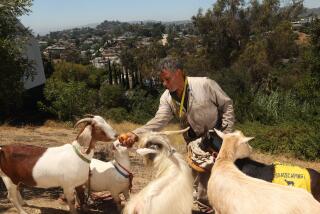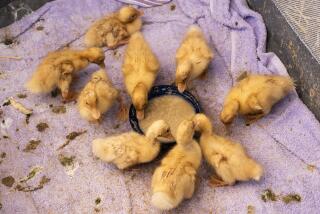Wild Goose Chase : Counters Try to Settle Question of How Many Honkers Visit Valley
- Share via
In the first minutes of daylight, while the earth lay chill under an amber sky and the grass sparkled with dew, a distant babble of geese arose, and a wavy V formation appeared from behind a hill.
As it flew overhead, honking uproariously, Art Langton raised an arm like a rifle and flicked his finger at the passing birds.
“One, two, three, 12, 25, 50, 75,” he said, sweeping by larger chunks of the flock with each tick. “That’s about 100.”
It was an imperfect count, give or take 50. Langton was 15 minutes too late for the optimum counting moment, when the birds took flight in small groups off a pond half a mile from where he stood on the road circling the dry bed of Chatsworth Reservoir.
But the day was not lost. Langton’s counting partner, Wendi Gladstone, was on the spot when the birds took wing.
“Nine hundred, forty-two on the pond,” Gladstone reported, when Langton and a third counter, Rosemarie White, caught up later.
The three Audubon Society members are part of a team of volunteers who are trying to settle the perennial question of how many geese settle in the San Fernando Valley each fall at the end of their migratory journey from breeding grounds in Utah and Montana.
Many Valley residents who have grown attached to the boisterous and stately formations of Canada geese worry that they have diminished precipitously over past decades as development wiped out all but a few vestiges of open space on the Valley floor.
But they can’t prove it.
Despite 40 years of interest in the Canada goose by bird enthusiasts and officials of the Los Angeles Department of Water and Power, there has never been a definitive census.
Past counts by the Audubon Society and DWP have suffered from the inconsistency of volunteer participation, lack of a standard method and the vagaries of weather.
So, this year, the San Fernando Valley chapter of the Audubon Society is conducting its most exhaustive survey yet, a systematic six-month project designed to document the connection between the migratory goose population and the few remaining areas of open space.
Each Sunday and Wednesday at 7 a.m. and again at 4 p.m., about 30 volunteer Audubon goose-counters spread out to the six areas where most of the birds gather: Encino Reservoir, Pierce College, Chatsworth Reservoir, Van Norman Dam, Hansen Dam and Sepulveda Basin.
Working in groups of two to six, they count the flocks as they take wing, marking the time on a form. The forms will later be tabulated to illuminate the movements of the geese from one part of the Valley to another.
The exercise began in October and will continue to April. Upon its completion, the volunteers hope, their data will establish a basis for measuring changes in the population in future years. Also, by tracking geese between major congregating spots, they hope to establish which areas are crucial to maintaining the population.
Anecdotal accounts suggest that several thousand Canada geese came to the Valley each winter when large open spaces still stretched across its floor decades ago, said White, a clinical psychologist who organized the effort.
White said preliminary results of the study show less than 2,000 geese in the Valley this winter, a considerable decline from past observations.
“We have not ever documented what are the reasons for that,” White said. “Speculation has it that it has to do with land-use, with lack of forage, with weather patterns and also the drought.”
Unlike other migratory birds that merely fly through, the Canada geese come to the Valley as a winter home, flying from one part to another each day in search of food. Their preference is for large open fields, where they can find fresh grass or grain and feel safe from predators, said Pierce College biology professor Ted Kinchloe, who is also participating in the study. When suitable fields are eliminated, the birds will not return, migrating instead to another area, Kinchloe said.
Kinchloe also believes past development has greatly reduced the goose population. But, illustrating the difficulty of proving that, their numbers have actually grown on the college campus in the past few years, he said--attributing the change to the development of Warner Center, once a favorite foraging spot, now lost to them.
Moreover, the Audubon Society’s own informal counts over the past few years--always conducted within two weeks before or after Christmas--have proved too erratic to establish any trend.
“They go up, and they go down,” said Langton, a junior high school science teacher who keeps records of the Audubon’s Christmas counts.
In the most recent count, 1,797 geese were tallied. In 1991, the count was only 1,000, but may have been distorted because of rain. The year before, only 1,400 were counted. Yet, as recently as 1988, 3,500 geese were counted, and in 1978, a year when the population is presumed to have been higher, the count was only 540 birds on a rainy day.
In its new count, the society hopes to eliminate the imperfections of prior results by sustaining the effort over the entire wintering season and counting simultaneously at all the major congregating sites.
With a solid census in hand--and a video about the geese that the society is producing under a grant from Bank of America--the society hopes to lobby to protect the remaining areas the geese favor.
So far, White said, the study shows there are only three areas where the geese can feed.
“They sleep at Encino Reservoir overnight, but there is no place to eat there,” White said. In the morning, “they fly out to Sepulveda Basin, Pierce College or Chatsworth Reservoir. Those are the only open spaces where they are able to find bits of grass and forage. That’s pretty sad.”
The feeding area at Pierce College has an uncertain future. As the college scales back its agricultural programs, about 200 acres are being examined for possible development.
“There are a lot of opinions as to what should be done, from re-establishing an agricultural curriculum to a golf course and even a shopping mall,” said Kinchloe.
The other two areas enjoy greater stability. Chatsworth Reservoir, which has been empty since 1969, remains an 1,100-acre reserve under the jurisdiction of the Los Angeles Department of Water and Power. The DWP built an experimental ecology pond that serves as the sleeping area for up to 1,000 birds. There are no current plans to change the use of the 1,100-acre reserve, said DWP spokeswoman Debra Sass.
Sepulveda Basin, leased from the U.S. Army Corps of Engineers by the Los Angeles Department of Recreation and Parks, includes a 100-acre wildlife refuge with an 11-acre lake used by the geese. However, the most important part of the basin to the geese lies outside the refuge--two fields of corn, grown by farmers who lease the land, where the birds can forage.
“We don’t have grain or things like that that they would like to feed on,” said Dick Ginevan, chief park supervisor for the Valley region. “They do go into the farmland. They will go in and get gleanings from the crop, once it’s harvested.”
Consequently, Kris Ohlenkamp, a former San Fernando Valley Audubon Society president who is responsible for the count in the Sepulveda Basin, said he hopes the study will encourage greater sensitivity by the farmers on their planting schedules.
This year, Ohlenkamp said, “they came in and plowed under everything and made it unavailable for the geese, so they had to move elsewhere. My interest would be coordinating their planting and plowing, particularly the plowing.”
Ted Carr, U.S. Army Corps of Engineers project manager for Sepulveda Basin, said the manager for the Tapia Brothers, who lease the farmland, plowed under the stubble while the geese were still feeding, but has agreed to wait longer in the future.
“He’s said he would work with them as much as possible, leaving the corn out,” Carr said. In the more distant future, the cornfields could be lost if the land is converted to recreational uses because money becomes available to the Department of Recreation and Parks, Ginevan said.
If the corn was no longer grown, the geese, being migratory, would find another place to winter, most likely in open space areas under state or federal control--which would not be good for them, Kinchloe said.
“These simply are areas where the geese go to get butchered,” Kinchloe said. “The hunting pressure on them is enormous.”
The loss would not necessarily represent a threat to the goose population as a whole, because the species is not endangered and the Valley is only a minuscule part of its continental flyway. The real loss would be the Valley’s, Kinchloe said.
“It’s a centerfold species as far as the San Fernando Valley is concerned,” he said “They fly in. They honk. They come from places unknown. They go to places unknown. It’s a signatory species that heralds our open-space heritage.”
Canada Geese Scientific name: Branta canadensis moffitti . Size: Up to 3 feet from the end of the tail to the tip of the bill for the moffitti , one of the largest of the 12 subspecies of Canada geese. Males weigh as much as 10 pounds, females 8 pounds. Field marking: Gray-brown body, black head and neck with a white chin strap. Population: Uncounted. At a minimum, hundreds of thousands. Range: Across most of northern and central North America, some subspecies extending north into the Canadian tundra in summer and south to central Mexico in winter. The moffitti subspecies is restricted to the Western United States, especially Utah and Montana in summer and California in winter. Life cycle: Migrate south in October and November, then back north in February and March to breed, mainly from May to June. Social characteristics: Form large flocks of 800 to 1,000, often divided into sub-units representing family groups. Pairs usually mate for life. As many as five offspring from the previous breeding season accompany their parents on the migratory flight. Flocks generally take flight when approached by humans. Feeding habits: Graze on upland fields and flat, open areas, preferring grains and fresh shoots of annual grasses. Will also eat aquatic grasses, root stalks and tubers, and animal life such as worms. In the San Fernando Valley, flocks fly each morning from sleeping areas, usually on water, to grazing sites. Predators: Humans. Geese are intensely hunted in rural areas. Where hunting is outlawed, there are few natural enemies. Primary cause of accidental death may be flying into difficult-to-see objects, such as power lines. Source: Kimball Garrett, ornithologist, Los Angeles County Museum of Natural History
More to Read
Sign up for The Wild
We’ll help you find the best places to hike, bike and run, as well as the perfect silent spots for meditation and yoga.
You may occasionally receive promotional content from the Los Angeles Times.







